Question
wanna start airbrushing my 1/24 scale models ---- mainly car bodies and play around with some creative details--i dont want to invest a lot but dont want junk--need something that will last and is fairly easy to maintain-- i live in an apartment i would like to use indoors,, any suggestions on what i should buy?? -is a compressor necissary -if you could tell me everything i need to finally get a good paint job!!---and if you got time is there a way to paint your models with acrilic paint with a brush and make it flawless??-or enamel--just a thought --much appricated
Answer
While I have seen some hand painted models it is a skill I have never been able to develope. Most really bang up jobs are done with airbrush. For that I would recommend a Paasche model "H". It is good, durable airbrush that is packaged with three different tips. It is cheeper than an Iwata, though some Hobby Lobby stores carry both and you can usually score one during Hobby Lobby's 40% of sales.
Acryllic paints are something that I have not gotten into and do not know much about. The advantage is that you do not have to use special thinners. Some modelers use Windex to thin. My experience is mainly with enamels. I have a friend that uses finger nail polish thinned with laquer thinner on his cars as he likes the range of colors and fine grain of the metallic/metal flake ones.
You do not have to have a compressor, some people prefer to use a CO2 bottle, but that seems somewhat expensive. Some of the discount tool companies (like Harbor Freight) stock inexpensive compressors.
Probably the most import thing to a good finish is good surface preperation. In other words a good clean. smooth surface. As I have gotten older I have developed a tendency to prime the surface and after that dries well to sand it with very fine grit paper. 3200, 2500, in that range. Afterwards I wash it and allow it to dry thouroughly. Thinning the paint is an art, not a science. That is something you just have to experiment with.
Tuesday, November 27, 2007
Airbrushing or not?!
Posted on
1:23 AM
![]()
Thursday, November 15, 2007
What is the difference between satin white & gloss white paint?
Difference between satin white & gloss white paint.
There are a few different sheens of paint. High gloss, gloss, semi gloss, satin, egg shell, and flat. The difference between satin and gloss is the amount of sheen. Gloss paint is usually used for trim and cabinets and has a very shiny look. Satin is usually used for walls that get a lot of traffic and is easier to clean than a flat. Remember that the higher the sheen the more visible the flaws will be in what you're painting.
Satin White is 50% Gloss White and 50% Flat White.
There are three levels of "shininess"
Matt - not at all shiny
Silk - a bit shiny
Gloss - shiny
Thank you.
Monday, October 29, 2007
The main techniques for applying decals.
 In previous my posts on this blog I have already wrote about how to glue different model parts, and you can read how to remove paint and chrome from a model and best method to remove old paint from a model.
In previous my posts on this blog I have already wrote about how to glue different model parts, and you can read how to remove paint and chrome from a model and best method to remove old paint from a model.
Today we will talk about Different and basic technique for applying decals to our models.
So lets go!
For Tricky Decals - Decals that seem to not to want to lay down can be coaxed into doing so with the following technique. WARNING - this is tricky - if you aren't careful you can make a big mess. Lift up the decal and apply a small amount of liquid cement to the model's surface with an old brush. Blow the decal down with your breath or use a light single stroke with a brush.
DO NOT TOUCH THE DECAL AGAIN!
The glue will melt the decal thus adhering it to the model. If you are careful this coes out great. If you touch the decal while the glue is setting it will smear like paint - the decal at this point it melted and until it dries is very susceptable to damage. Once it dries it will be fine. I've used this on old decals (from 1960's kits) and those tricky
German losenge patterns.
Wait 2-3 days before dullcoating - Always wait at least two days after applying decals before applying a dull or gloss laquer coat. The moisture in the decals will react badly to the laquer if you coat too soon and the decals will wrinkle.
- Cut away all decal film you can do easily. Use a very sharp knife, don't press hard as you don't have to cut the paper.
- Put a few drops of Micro Set into the water before you wet the decals.
- Wet the decal, but don't let it stay in the water.
- Apply Micro Set to the surface you want the decal.
- Slide it there.
- Press down with a soft brush, blot off excess water.
- Brush on Micro Sol, press down gently.
- Place the kit so the decal lies horizontally (if possible).
- Let dry slightly, apply more Micro Sol, press down. Don't worry about small wrinkles, but try to smooth down large ones. The decal will contract again when it dries.
Repeat about twice.
No guarantees, but this is what works best for me.
(Posted by Urban Fredriksson)
Wednesday, October 24, 2007
Tamiya Porsche Boxster plastic model car kit review.

(More photos of the final model are bottom of this page.)
Review was made by Trygve Isaacson.
Since I have been eagerly awaited delivery of my red Boxster Arena, I thought I would try a model of the building. I have never seen a pattern in my life, so I wondered if it would all come right. It has. The following are some pointers and advice from the building, with photographs of the process and the final outcome. Regardless of whether you are waiting for your Boxster to be built, or already have, I can definitely recommend creating your own model, which has your colors. It is not very difficult, and it's fun. Let paint for drying time between work sessions; You can probably project in a handful of 1 - or 2 hours.
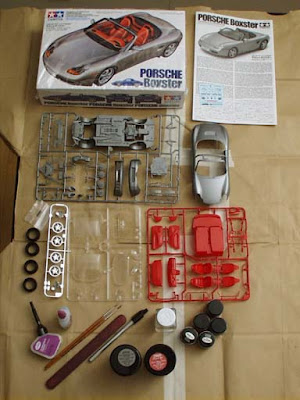 I had seen a reference to the Tamiya Model Kit (# 24187, 1 / 24 scale, 7 cm long) on the Boxster Board, so I www.tamiya.com examined, and they even had a dealer list, which Hobby Shop five minutes from my house. I listened to and noted that, in order for me and you again in a few weeks. When it came, I had no idea what would be necessary to build, but the people in the hobby shop were so friendly to fix me with the necessary project returns. The parts in the model kit actually has specific Tamiya paint figures, but you can find correspondences.
I had seen a reference to the Tamiya Model Kit (# 24187, 1 / 24 scale, 7 cm long) on the Boxster Board, so I www.tamiya.com examined, and they even had a dealer list, which Hobby Shop five minutes from my house. I listened to and noted that, in order for me and you again in a few weeks. When it came, I had no idea what would be necessary to build, but the people in the hobby shop were so friendly to fix me with the necessary project returns. The parts in the model kit actually has specific Tamiya paint figures, but you can find correspondences.The model kit was 30 dollars. Further information: Testors 3 ounces. Spray paint cans (FS36251 Navy aggressor Gray (primer), 1247 Gloss Black, 2905 Burgundy Red Metallic, which I hope, in the vicinity of Porsche Arena Red Metallic), Testors 1 / 4 ounces. Brush on glossy enamel colors (1145 white license plates, 1147 black for many things, 1111 dark blue for chassis), Testors 1 / 2 ounces. Melting custom brush on colors (silver chrome FS17178 for chrome pipes, 1780 steel for various metallic objects, flat black for FS37078 Cabriopersenning and other objects, Turn Signal in 2723 and 2724 Amber Stop Red Light for brake lights and turn signal), 1 / 2 ounces. Cyanoactrylate (uh, Super Glue), Testors 1 oz. Clear Parts Cement (special invisible adhesive for clear plastic parts), paint thinner, nail file / sandpaper x-acto knives, small wire cutters (to cut the parts from the plastic model forms), tweezers for holding by hand into small pieces painting, kids brush (sizes 2, 0, and 5 / 0). Total cost of the kit and all the supplies to about 65 dollars.
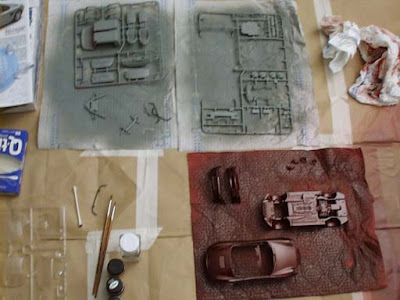
There are essentially three plastic parts with bars that you cut (01 mostly parts to be painted and the other parts usually painted on the outside, and with a clear plastic to left alone or spot-varnished), as well as the body, chrome parts and tires.
The first thing to do is to spray a coat gray primer on the parts, which are painted. Lesson learned: Let it dry! I have the bug starts to paint and paste some of the suspension pieces from the primer was completely dry. If you're going to glue a piece of paint or a paint primer, let it dry overnight. If additional layers of the same color to a piece, to do so may be within 3 hours after the last coat.
Color for the body pack (chassis, body, bumpers, exterior mirrors, and engine intake vents), apply several layers of the desired color. My mistake was to worry about the complete coverage on the first layer, a first in the thick mantle and some chunkiness. It is better to multiple thin layers, repeat until it is completely covered and solid. Be patient.
Once you've got the most important sections of primed and painted body color parts in your car is outside color, and it's all dry, you are ready to start cutting pieces out of the grid, from the grinding, painting and gluing.
Painting the Undercarriage
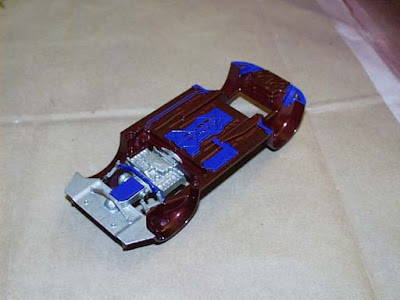
I do not know why they say blue for the chassis accents, but I follow the instructions. Is it really under blue? The engine and the rear deck are gray metal.
Assembling the Exhaust
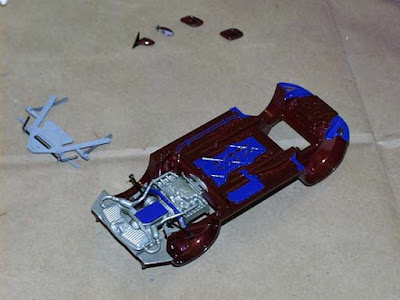
The exhaust assembly used metal gray color for the pipes with chrome accents at the terminals. For the exhaust muffler, the color of paint instructions for something that I did not think would be until I tried it: Mix paint with chrome flasher Bernstein. The result is a somewhat tarnished chrome color. It works well for the muffler, which definitely is not too bright chrome. The stem is a separate piece from the parts chrome grille.
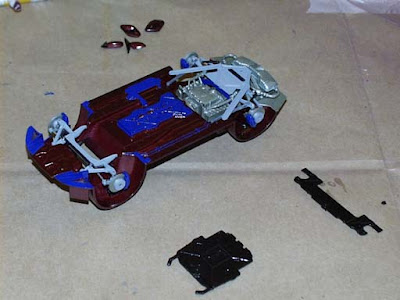
That is, if you add some complex assembly and bonding. Again, I recommend that you use the paint plenty of time to dry before you stick pieces together. Otherwise, you can use glue with a soft surface, which are not. Patience!
Follow the instructions in regard to certain items that you are not stuck together. Most important is the front suspension, which allows the wheels to turn, because they are not totally glued. You are advised to unplug from between the wheel wells and cross bars, but pivotable.
The rear suspension is the most difficult to stick. Once assembled, the entire assembly is the one on the engine and exhaust, in a large meeting, attaching at least eight points stick. It is difficult, they are all capable of quickly before the glue. I had two points glue that is not quite true, but at the end it is not really significant.
The rotors and calipers are glued to the suspension, but in each rotor is a rubber seal that is not glued. The wheels will attach using this seal, the remaining rollable.
Finishing the lower part of the body

With every piece of suspension in effect, the two pieces meet, which get painted radiator grille, and wheels and tires slide Customs This is a little nerve racking, because you have to pretty hard, and it seems like the suspension will Snap In the pressure. Actually, I had another Glue the rotors before that I was not completely dry when I glued.
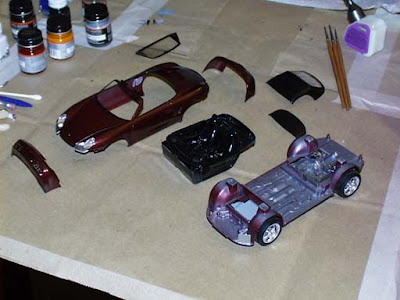
Once you remove the non-interior pieces from the grid, you can spray all of the interior pieces still on the grid. My interior is black, based on the work easier, I could just spray the whole thing black. Interior with other colors you need to spray the inside of color, and then hand paint on many small black spots in the cockpit.
This is also a good time to paint the hand from top to bottom tonneau pieces and the upper piece until soft. I did not bother painting the hard top, because I am not always. It is also a good time to the various black trim parts as the windshield, brakes and engine intake grilles, and the bumpers and fender flares.
Finally, there's still a fair amount of outside work to be done. The chrome and glass parts like headlights, taillights, windshield, rear-view mirror, exterior mirrors, etc. must be painted and / or glued.
For fear of a permanent error, I chose not to the interior section adhesive or upper body to the lower part of the body. The fit is tight enough to simply good.
For the rear deck Boxster logo, I only have a little black paint on a piece of paper and touched them in the light, the lettering. I did not want to screw it up by brushing up and get it in between the letters.
The stickers suck. I had little success getting them to stop. I have two of the wheel Cap stickers, and participated in a small adhesive for the hood badge stickers and sticker brake light, which is also a little too big.
I left the soft top unglued, so that it lifts from the top down. It is not quite fit flush against the top of the windshield, but it could, if I had decided to permanently glue at the top of the soft.
The final product!
Here are some photos I have a Olympus D-500L digital camera. Click on an image to the photo in full size. (Actually, they are half the size. The originals were 1024x768.)

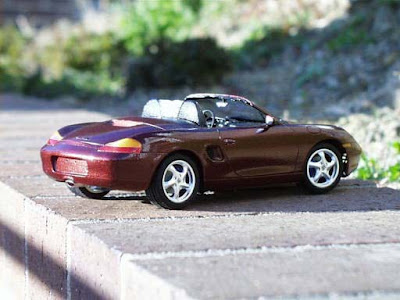
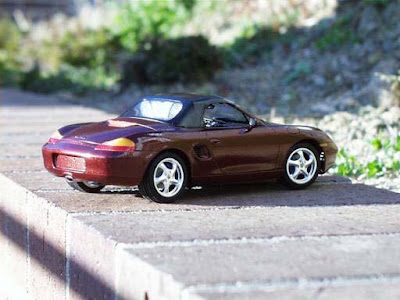

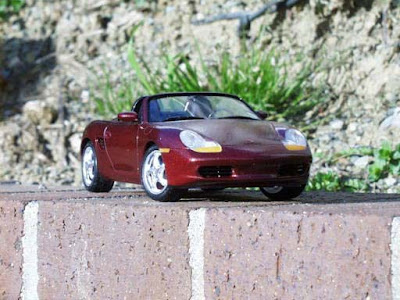

Posted on
7:49 AM
![]()
Tuesday, October 23, 2007
Friday, October 19, 2007
Model kits form Japan vs USA. Who is better
at the net, but rarely solves nothing. As ammunition the next time
around, consider the following questions:
"Serious modelling" is much more popular in Japan than in the United States.
This probably goes back to the roots of Japan-modeling, simulation
Earlier pastimes for the rich, while in the United States it has become
From childhood toys. In any case, Japanese manufacturers are able to
to sell higher end (expensive) materials in their domestic market, and this could
better to justify production processes, such as high-tech part of many forms
, which can produce more sophisticated and better quality (and lower sinkmarks
seams) parts.
- What do you mean by "better"? accuracy? building quality? part match?
Want to be a absolute scale or quality / dollar? Although most
agree that the Japanese are more kits cubes quality debate
in r.m.s shows that they are not significantly better than others
fronts. Japanese kits are usually quite a bit more expensive, as
well, often 2-3x dollars of its competitors, often giving the province made in the USA
packages cost.
- The desire of producers reuse of previously existing forms
difficult to make apples to apples comparisons. Truly new
kits of the U.S. closed the quality gap, but many
The United States is now in production on the basis of sets of forms, which are 10 to 20
years, clearly they are not, and never will be as good as
a more modern set of any organ.
And what are you thinking about? !
Posted on
5:16 AM
![]()
Tuesday, October 16, 2007
How to glue different parts of model
When we build models, we always ask, how to glue together different non-similar parts. Here is some answers for yours questions.
What should I use to glue together dissimilar materials?
There is not one pat answer to this. 2 part epoxies and cyanoacrolates are probably the best. And depending on the application, one could also use contact cement.
What should I use to glue together to metal parts?
This is particularly important to figure builders, since many figures and parts are made from white metal. One of the oldest and probably best ways is to join metal parts is by soldering them. If you don't want to learn to solder, then adhesives can be used. If the parts mate
very snugly, particularly 2 flat surfaces, superglue works very well. For surfaces that do not mate quite as well, gap filling thick superglue is one option. 2 part epoxy is also something that can be used.
What should I use to glue wood to wood?
The best glue for wood is Alphatic resin, carpenters glue. It produces a joint that is stronger than the wood itself usually. [In the US, Elmers is a common brand - the yellow stuff sold in hardware stores, *not* the white glue sold most everywhere else.]
What should I use to glue wood parts to styrene parts?
There are several options. Some suggestions are:
1) You could try using superglue with an accelerator. This would probably have to be thick superglue, unless you are using a very dense wood. Thin superglue would tend to absorbed by the wood like a sponge.
2) 2-part epoxy would probably be best, since it works well at joining dissimilar materials.
3) If the styrene is thick enough to withstand heat, hot glue may work well.
And Gluing Styrene to wood or paper is a pretty typical thing to do when assembling flying model rockets. Tube type plactic cement works fine - that's what Estes recommends. CyA also works. Glue soaking into the wood really isn't much of a problem. I use thin CyA to attach balsa fins to paper body tubes all the time - hold the parts in place and add several drops of CyA. It does soak into the end grain of the balsa and the paper tube so you have to use several drops instead of just one drop like you might between nonporous surfaces, but it works quite well.
It seems that the super glue that I am using glues my fingers better than the model parts, why? :-)
This is quite natural, considering why cyanoacrylate was developed.It was developed for doctors as a way to seal wounds without sutures during Viet Nam. In the field, with the many wounds, if a way existed to quickly seal a wound with out stitches, more people could be saved.
So, biological things such as fingers are joined very well by CA.
Thank you.
materials from (www.ninfinger.org)
Thursday, October 11, 2007
Interesting web sites about plastic models.
Hello! Today I want to give you interesting links to model kits sources:
--- Here you can check review of new Miniart Street w/Ruined House diorama review Miniart 36001
--- Here you can find three review of Antonov aircraft on different manufacturers (Roden, Zvezda etc)
--- Here you can check the new Tamiya releases
Posted on
6:32 AM
![]()
Wednesday, October 10, 2007
World War Guns on mules
During World Wars German mountain gun crews transported their guns on animals. The best was the mule. And you can check how this looks on photos.

Posted on
4:28 AM
![]()
Monday, October 8, 2007
Is-3 Stalin Soviet Heavy Tank. Model Review. 1/72
Hello friends. Today we will talk about Soviet heavy tank IS-3 "Stalin" by Roden manufacturer.
This will be a review of Roden 701 model kit in scale 1/72
History:
The Iosif Stalin tank (or IS tank, named after the Soviet leader Joseph Stalin), was a heavy tank developed by the Soviet Union during World War II. The tanks in the series are also sometimes called JS or ИС tanks.
The heavy tank was designed with thick armour to counter the German 88 mm guns, and sported a main gun that was capable of defeating the new German Tiger and Panther tanks. It was mainly a breakthrough tank, firing a heavy high-explosive shell that was useful against entrenchments and bunkers. The IS-2 was put into service in April 1944, and was used as a spearhead in the Battle for Berlin by the Red Army in the final stage of the war.
The IS-3, a heavy tank, developed at Experimental Plant No.100, under the leadership of M. F. Balzha in 1944-45, was the latest Soviet tank developed in the course of the Great Patriotic War.
A special commission was formed in 1943 to analyse the reasons for the horrible losses suffered by the Soviet military tank units in the Battle of Kursk (6064 machines were lost during the 38 days of battle). Based on the commission's proceedings and on the IS-2, a new heavy tank, the IS-3 was designed, this tank was considered a breakthrough design. Its hull was welded from rolled steel armour plate with the maximum possible slope on the front glacis plate. The tank was also provided with a cast gun turret, having the shape of a flattened hemisphere, which gave it a more streamlined appearance. The thickness of the frontal armour was increased considerably, owing to a reduction of armour thickness in other less vulnerable areas. Thus, the frontal armour plates of the hull were 120 mm thick, while the front of the gun turret was 230 mm thick. Having the same overall weight after the modifications, the tank had 1.5 times less frontal area. In addition this tank was equipped with a commander's control system for gun turret rotation.
Production was started in May of 1945, and continued up to mid-1946. At the end of the War 29 tanks were produced, with their total production number continuing on to 2311.
The IS-3 was not used in any military action during World War II, but on September 7th 1945 a tank regiment had taken part in the parade of Red Army Units in Berlin, being dedicated to the victory over Japan.
The IS-3 had been modernised by the end of 1950's now being named the IS-3M.
The tank was not considered an export model, although two machines arrived in Poland during 1946, while another machine arrived in Czechoslovakia with the purpose of familiarisation and instructor training. A considerably larger number of tanks were sent to North Korea, which in the 1960's had two operational regiments of IC-3's. 100 IS-3 and IS-3M heavy tanks were delivered to Egypt from 1956 to 1967.
Model Kit review:
So let check the box.
Number of kit is 701
So look up inside the box. We can see there some molds, resin details, decals and specification.
real photo of built this model kit.
Thank you for attention.
Thursday, October 4, 2007
How to remove paint from plastic models
Have you ever painted a model and did not like the look of the paint or maybe you have an old model you would like to redo but dont know how to go about it.
Here are a few tips that will help you. When Stipping paint from plastic models you have to be very carefull what you use or you may damage the plastic. The best prouduct I have found to work is called Purple Power or CASTORAL Super Clean Engine Degeaser and it should be avalible at most Retail Auto parts stores such as Auto zone or advance auto. Warning: Besure to test the solution you are using on an unwanted part before putting your model in it to besure it does not damage the model.
Fresh Paint. If you have a model that you have just painted and the finish looks bad and you would like to remove the paint find a container that is big enough to hold the model. Once you have done this you will need to add just enouph Purple power or Degreaser of you choice to completely cover the model. On freshh apint it should take 24 to 48 Hours for the paint to completly soften. You will need a pair of latex gloves and an old tooth brush to help remove the paint from the cracks and creases. Once you remove the model from soluction take your paint brush and gently brush across the surface and in the cracks. I have found it best to do this in a sink or area were I can have a flowing supply of water to help rinse the paint and solution off of the model. If by chance you findsome areas were the paint did not loosen just repeat steps above.
Old Dry Paint. Here is were patience comes in handy. If you have an old model that has been painted for some time or has several layers of paint it will take a little more time to strip. Follow the same steps above when starting the process but you will have to repeat it a few time. The best way to do it it is let it soak for 48 hours then remove it and brush away as much paint as possible. Then let it soak for another 24 to 48 hours and repeat process. You should have no problem redoing any model using thes steps.
BUT REMEMBER ALWAYS TEST YOUR SOLUTION BEFORE ADDING THAT UNREPLACEABLE MODEL SO YOU DO NOT DO ANY DAMAGE THAT CAN NOT BE FIXED.
By the way, you here is interesting information indeed acrylic paint.
Thursday, August 30, 2007
Models of figures = Model of vehicle
Today I think about one interesting thing.
Why plastic model kits of vehicles with many molds, details, decals cost as much, as kits of figures with one mold and pure number of low detailed parts.
I'm a new fan of modeling and don't know WHY THIS HAPPENS!!!
Hm...
Posted on
4:29 AM
![]()
Tuesday, August 28, 2007
Hetzer (early version) German Tank Destroyer
This is a model kit from exUSSR manufacturer UniModels.
Here are you welcome.
Hetzer tank destroyer in 1/72 scale!
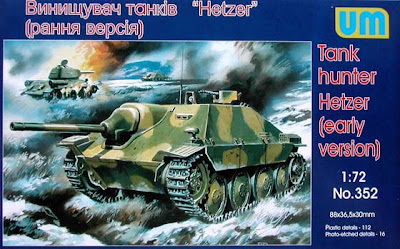
This kit contain 112 light grey plastic parts on four sprues, 16 PE parts on one fret, decals for six or more vehicles and a 4 page A5 instruction booklet with history, parts plan, 11 clear build diagrams and 3 paint/decal drawings.
Highly detailed, The only early production Hetzer in 1/72 scale and machine gun shield plus side skirts in PE.
First issued in 1944, the Hetzer was a very successful tank Hunter (Jagdpanzer). With a very low profile, a 75 mm gun and a remote controlled MG it could take on anything the Allies could throw at it. Even though it's armour was quite thin, it was sloped at such an angle that it gave it's crews good protection.
Although the Hetzer was based on the 38(t) light tank, very little of this kit is from the earlier UM 38(t). Even the two track/suspension sprues are new with only the tracks themselves, bogies and a small number of add-ons carried over from the older kit. Marketed as an early production model, the sprues also contain all the parts for the Late Production Hetzer and the flame thrower Hetzer.
Therein lies the first minor problem. The early vehicles had road wheels with 32 bolts securing the armour plate to the wheel, but it was found that these bolts loosened in combat. Later vehicles had the armour riveted to the wheels, and the number was reduced to 16. Unfortunately, the kit comes with the late wheels only. You do get the late and early gun mantlet, engine deck, idler wheel and exhaust. You also get an optional non-perforated equipment box in plastic and the perforated box on the PE fret as in the earlier 38(t)s.
All the parts are nicely detailed and flash is at an absolute minimum, but care will have to be taken assembling the lower hull to make sure everything is aligned or the upper hull will not fit.



The PE fret contains some very nice side skirt armour, (Shutzen, not sure if that's the right spelling), the MG shield, a perforated heat shield for the early muffler, periscope shields, guard supports and the afore mentioned equipment box.
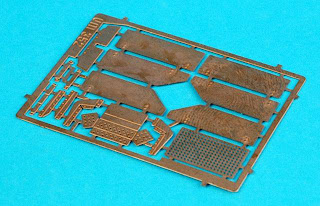
As usual for UM, they give you more vehicle markings than there are instructions for, but I guess to many is better than not enough.
My one criticism of this kit, apart from the wheels, that is, the hatches are all closed. Again, nit picking, as they shouldn't be hard to open.
Esci's Hetzer was one of their best. This kit from UniModels, I believe, will leave it for dead.
Thank you for attention!
Good luck and comment my post please in any questions!
Monday, August 20, 2007
Revell 1/72nd U-Boat
But for such a large model, it goes together relatively quickly and easily, though I found the rudders and stern diving planes somewhat fragile, and the odd shape of the dismounted conning tower makes it all too easy for it to roll off the workbench. Ask me how I know that. Sharp-eyed viewers will note that the optics at the top of the attack periscope are missing - they snapped off when the conning tower rolled off the bench and were never seen again.
I spent a lot of time opening up the free-flood holes in the hull, and in a way I wish I hadn't. I didn't duplicate any of the pressure hull behind the free-flood holes, so in the right light you can see all the way through the hull and it just doesn't seem right.
I decided to build it as Erich Topp's boat from earlier in the war ("U-552 Early" in the instruction sheet) though purists will note that I didn't apply Topp's Red Devil marking to the conning tower. Maybe someday, but my decal sheet was damaged by exposure to high temperature, wind, bad vibes or something and I only barely managed to salvage the decals on the base. Later, when I have more nerve, I'll try Topp's personalized markings, but for now, I'm simply pretending that the Red Devil washed off in high seas.
Buy lots of paint! The hull consumed a full bottle of Model Master flat black, and I still had to touch up here and there with a little bit of hardware flat black. Still, I knew I was going to weather the boat, so I didn't worry about the coverage too much. I weathered the boat with pastel chalks for the most part. I use a stiff white artist's brush to grind pigment off the bars of chalk, which is cleaner and easier than rubbing the stuff on sandpaper, and I kept sealing as I went along with Dullcoat. The clear flat spray darkens and tones down the weathering, so for a while I was scrubbing on pure orange and hoping that it would look all right overcoated. I think it does.
I found the Squadron "U-boats In Action" volume useful in building this kit.
There is no crew, yet. A while back I bought Revell's vinyl "Kriegsmarine" figure set and will add a few figures to the boat. I'll probably use the guys in slickers on my S-100 and add a couple of nonchalantly-standing guys to my U-boat just to give it an impression of scale. Any thoughts of showing the crew manning the deck gun were dashed when I hung the kill pennants from the overhead rope, but none of the Kriegsmarine figures look much like Topp and his bridge crew lounging in the sun while the boat arrives in port. So I'll just throw in one or two guys for scale and call it good.
Thanks for attention!
Tamiya 1/35th SdKfz-250/3
Hi friends, You can Check this kit! This is Tamiya 1/35th SdKfz-250/3.
Tamiya's SdKfz-250/3 command halftrack, with General Rommel. I built this straight out of the box originally intending to sell it. (I don't generally keep 1/35th scale armor models) but somehow it sort of hung around. It's a nice kit and a fun time, but I painted the non-Rommel uniforms with Gunze Sanyo paint and I didn't much care for the semigloss sheen it left on clothing. I tried overcoating the guys the clear flat a couple of times, but to no real avail.
Posted on
7:35 AM
![]()
Verlinden 120mm U.S. Grant figure
I like painting figures, and seem to have the most fun with figures around the 120mm mark. Larger than that and they get kind of cumbersome and tedious; smaller than that and they become difficult for me to paint. But 120mm is a nice size, at least for me.
Mostly I used so-called "craft paints" on Grant, mostly Delta Ceramcoat. I like these paints because they're easy to access, are quite inexpensive, mix easily, and clean up easily. They don't stick particularly well and like all acrylics don't support on-the-figure shading and highlighting, but I'm not that involved. If my technique of using washes and drybrushing won't win me any awards at model shows, well, I'm okay with that.
Thank you for attention!
Posted on
7:31 AM
![]()
Model Kits trash Art!
After making some of kits we have so much trash and pieces of plastic molds, BUT some of us have the good ideas in future style! Please, you can check this fantastic TREE!!
Artist Harm van den Dorpel makes constructions and artwork made out of Revell plastic model kits, check out his other works too!
So! After this post do you have some ideas, folks?!
Posted on
6:59 AM
![]()
RAF BE 2c. British Fighter WWI in 1/48 scale.
Hi! I will talk about RAF the british aircraft in WWI. This model kit is NEW 2007 year model kit by RODEN manufacturer. Scale of kit is 1/48.
A Royal Aircraft Factory B.E.2a (Bleriot Experimental) of No.2 Squadron R.F.C. was the first aircraft of the Royal Flying Corps to arrive in France after the start of the First World War, on August 26th, 1914.
VARIANTS:
SPECIFICATIONS (B.E.2c):
General characteristics
Performance
Armament
In 1914, immediately after the beginning of World War I, it became obvious that the British Army needed to develop an aviation component. Aircraft were not yet considered as fighters or bombers; at that point their function was seen to be reconnaissance and observation of the movements of enemy troops. The Army needed an aircraft which wouldabove all be stable in the air during the protracted patrol periods, and also allow for the imperfect standards of construction of the time. The first substantial order went to the government's Royal Aircraft Factory (RAF). In pre-war years it produced a two seat plane, the B.E.2, under the direction of graduate engineer Edward T. Busk(B.E. - 'Bleriot Experimental', because it had a tractor configuration, like the aircraft of Frenchman Louis Bleriot). The design appeared to be successful, and orders for its manufacture were given out to such firms as Handley Page, Vickers, and Hewlett, as well as the state enterprise. At the beginning of the War the B.E.2 was delivered to the Army as an observation aircraft.
The pace of development in aviation was such that the B.E.2 became obsolete in a matter of months. Edward Busk modified the construction of the B.E.2: the lower wing of the biplane was staggered rearwards in order to improve the observer's field of view, the form of the empennage was also changed, and the wings were fitted with ailerons. This new version was the B.E.2c and it was even more stable in flight than its predecessor. Both the Royal Flying Corps (RFC) and the Royal Naval Air Service (RNAS) requested the type. The Royal Aircraft Factory did not have the capacity to execute such an enormous order,and so licenses for its construction were given to such firms asBristol, Vickers, Armstrong Whitworth, Wolseley, Ruston Proctor and others. During 1914-1915 more than 2,000 B.E.2c's were built, along with the B.E.2d (which mainly differed from the B.E.2c in having anadditional fuel tank under the top wing).
The first B.E.2c appeared at the Front at the beginning of 1915. Its basic tasks in the sky of the Western Front were reconnaissance, artillery spotting, and the bombing of enemy troop formations. This variety of two seat aircraft, with an observer in the front cockpit and a pilot in the rear one, quickly became outmoded, and the B.E.2c lost more and more air battles to newer German two seaters. Its shortage of engine power restricted the scope for improvement, andthat is why the B.E.2c remained in the front line only for a short while. However, when the Sopwith 1? Strutter, De Havilland DH4 and Bristol Fighter appeared, its roles were limited to the interception of huge slow Zeppelins, and training. It should also be noted, that B.E.2c pilots from emergency flights destroyed at least five giant German Zeppelins. However they were already obsolete in 1917 even for the role of interceptor, and they gradually yielded their places to newer types. The only role left for the B.E.2c was in training, and at the end of WWI only a few machines of the type remained from more than 2,600 produced overall. By the beginning of the 1920s all of them haddisappeared for good, and the only B.E.2c remaining is in the Imperial War Museum in Great Britain. This exhibit, an extraordinarily elegant aircraft, is a rare living representative of the first few years of the war in the air.
1. RAF BE2c “4395” No. 14 Squadron RFC (Expeditionary Forces), Arabian region, 1917.
2. RAF BE2c "10000" The only British aircraft with five-numeral serial number, Blackburn-built. It was delivered to the RNAS Observers School Eastchurh, July 1917.
3. RAF BE2c “1741” No. 12 Squadron RFC, Western Front, France, March 1916.
4. RAF BE2c “2509” No. 2 Squadron RFC, presentation aircraft, it was paid for by Mrs. H.P.Stromberg of New York City, end of the 1916.
5. RAF BE2c “8407” equipped with the Le Prieur rockets, aircraft based at Cranwell, early 1918.
6.RAF BE2c “4451” early-built aircraft, based at Eastchurch and Grain, early 1916.

Posted on
6:37 AM
![]()
About this blog
Hi everybody! My name is Artem. I'm living in Ukraine and I like model kits!
I opened this blog for many peoples who likes model kits like me.
Thank you for attention!
Posted on
6:28 AM
![]()









